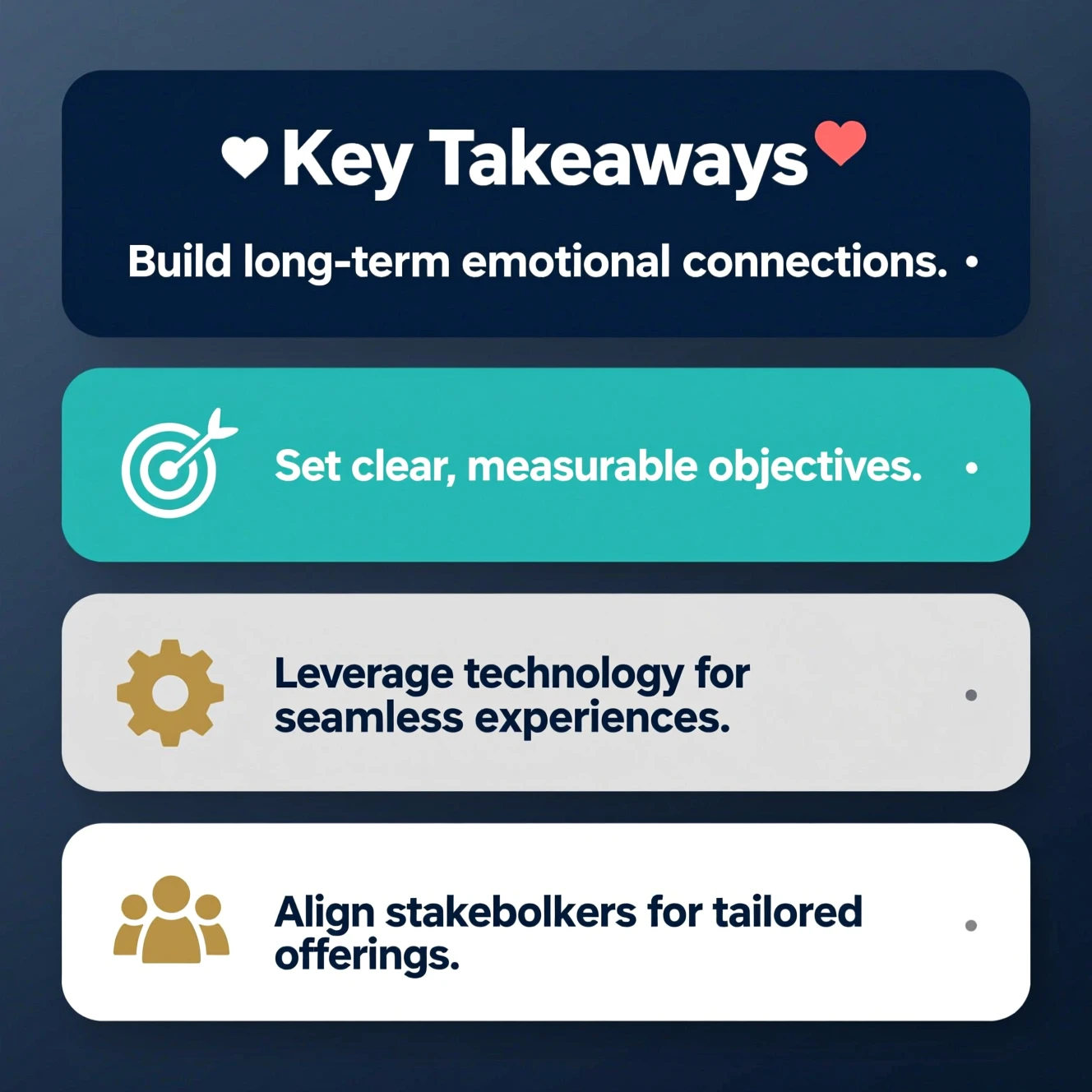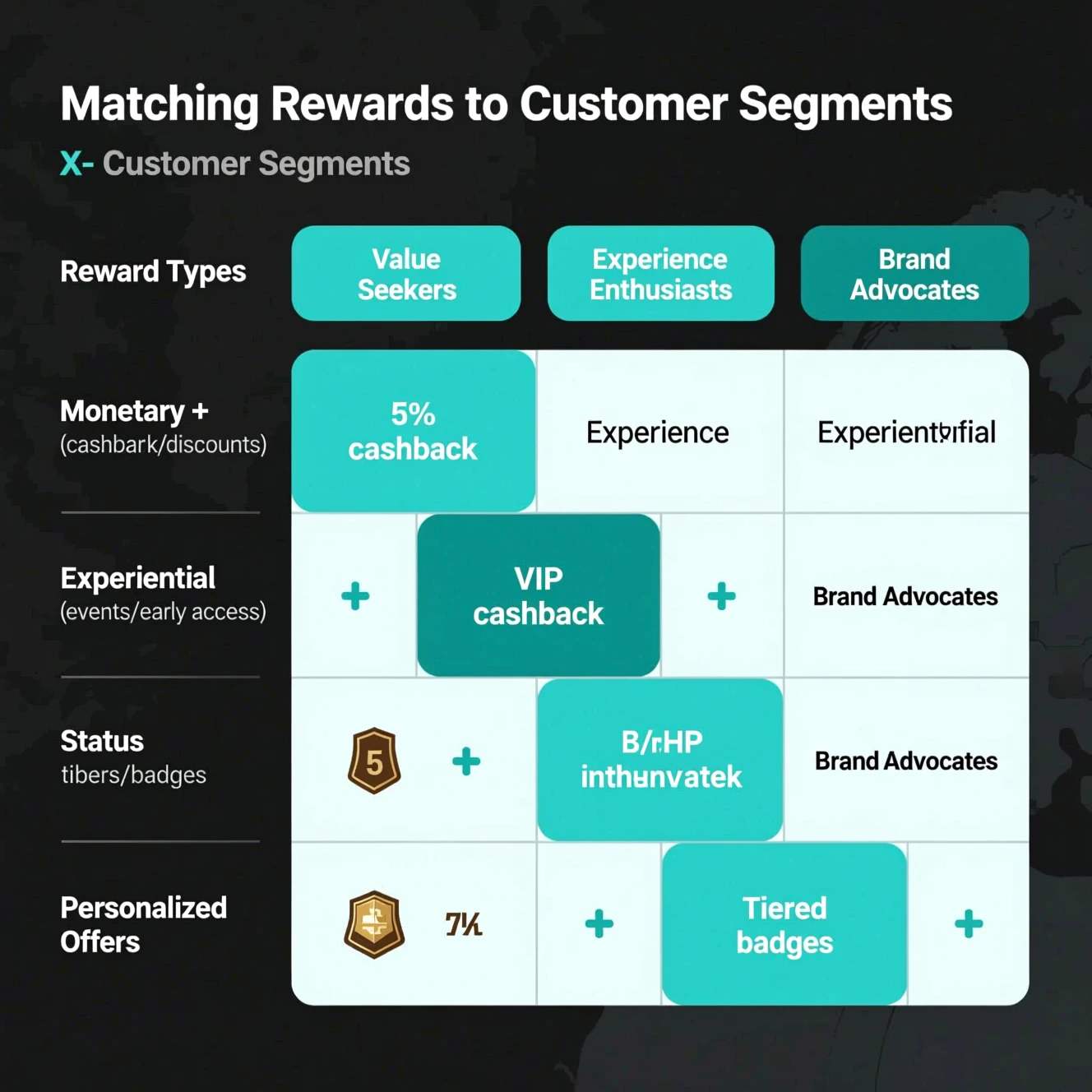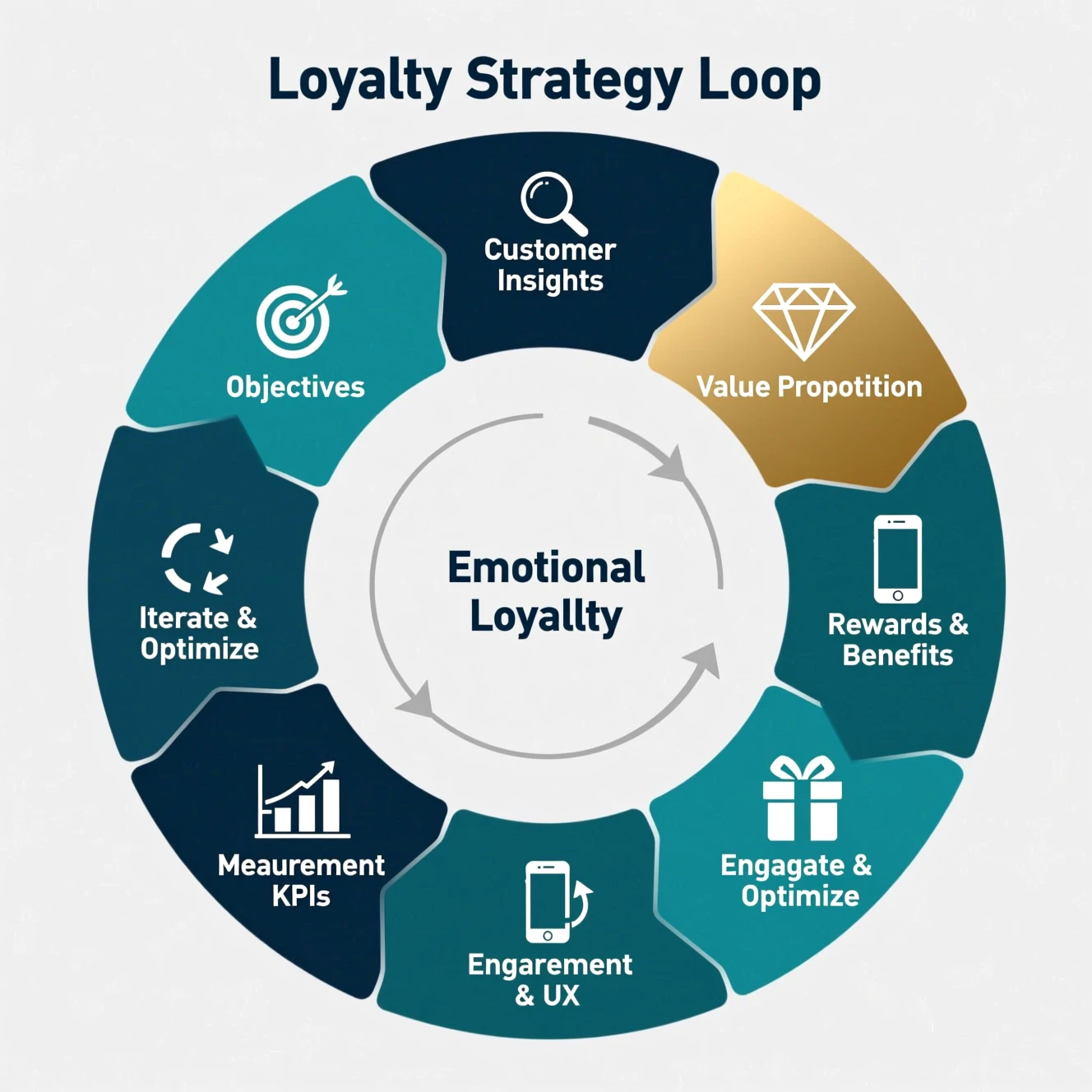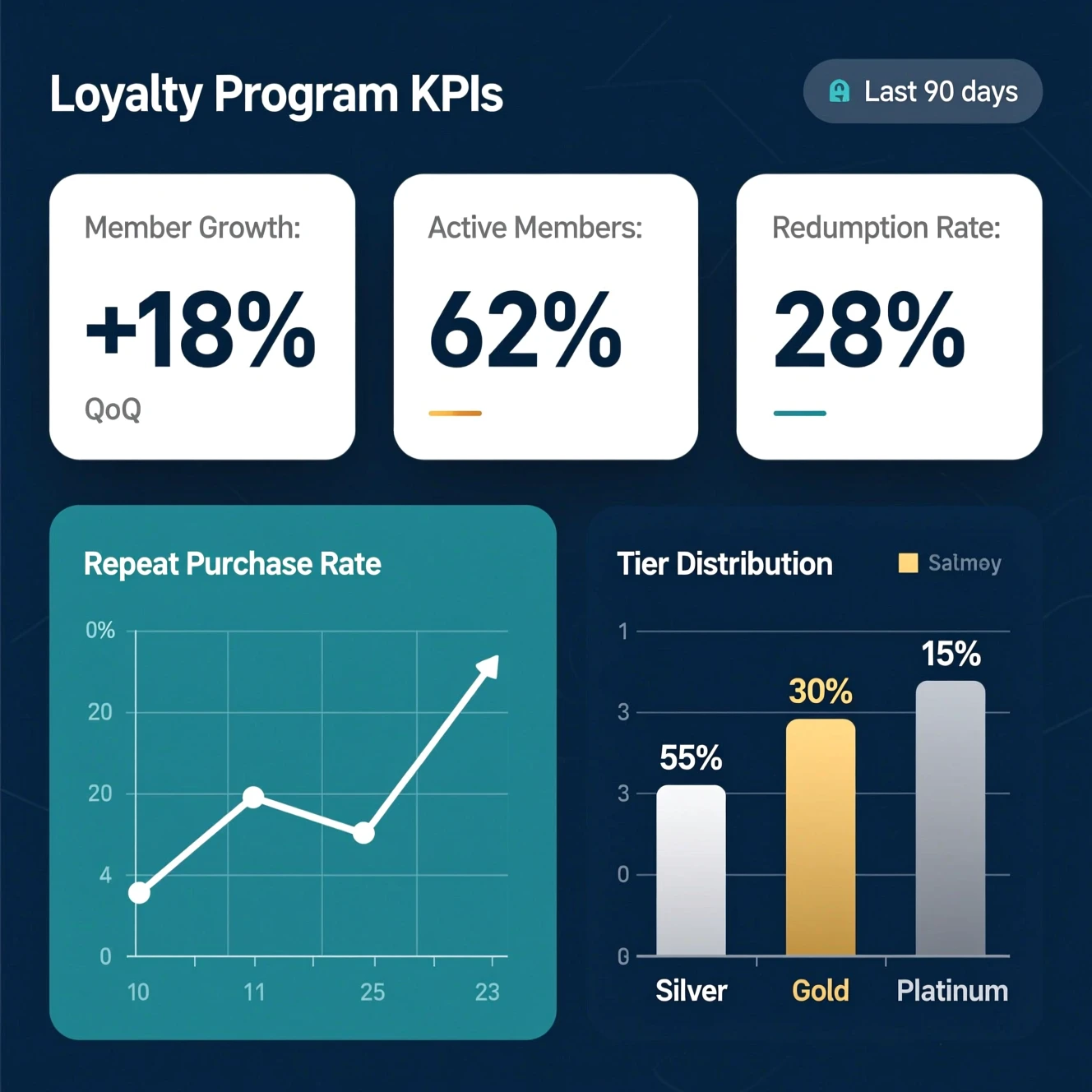Want to build a loyalty program that boosts customer retention and engagement? Start with a solid strategy for loyalty programs. This article will teach you how to set clear objectives, offer valuable rewards, and use customer insights to your advantage.
A well-defined loyalty program strategy is the cornerstone of fostering lasting customer relationships. Unlike traditional marketing efforts, which often focus on short-term gains, loyalty programs aim to build long-term emotional connections with customers. This involves understanding and responding to customer needs, preferences, and behaviors through a data-driven approach. Leveraging customer data allows businesses to tailor their loyalty programs to align with member needs and values, ensuring relevance and effectiveness.

The primary goal of a loyalty program strategy is to encourage repeat purchases, build emotional loyalty, and engage customers in meaningful ways. This is achieved by:
Key elements for a successful loyalty strategy include setting clear objectives, crafting a compelling value proposition, and understanding the customer base. Focusing on these elements enables businesses to create a loyalty program that exceeds customer expectations. This involves providing rewards, exclusive access, and personalized offers, making customers feel valued and appreciated.
Ultimately, a well-crafted loyalty program strategy drives customer retention and business growth, turning loyal customers into brand advocates, enhancing customer lifetime value.
Building an effective loyalty program requires incorporating behavior motivators, sentiment builders, and engagement activators. These elements work together to create a holistic approach that keeps customers coming back. An effective loyalty program must focus on understanding customer preferences, offering relevant rewards, and clear communication of value. Balancing personalization and innovation helps businesses sustain customer loyalty over time.
The cornerstone of a successful loyalty program includes:
The key elements of an effective loyalty program can be broken down into three main areas: setting clear objectives, crafting a compelling value proposition, and understanding your customer base. Each of these elements plays a vital role in creating a loyalty program that resonates with customers and drives long-term engagement.
Defining clear objectives that align with high-level business requirements is crucial for creating a successful loyalty program. These objectives should be specific, measurable, and achievable, ensuring that the program can be effectively evaluated and adjusted over time. Choosing the right type of loyalty program is vital; it should fit your defined objectives to ensure success.
A balanced scorecard approach can help track loyalty program strategies, emphasizing long-term customer relationships and brand affinity. Setting clear objectives allows businesses to create a business model roadmap for success, aligning every aspect of the loyalty program with overarching goals.
A loyalty program should focus on providing benefits that are unique and meaningful to customers. Delivering value through exclusive benefits can significantly strengthen customer loyalty. For example, offering rewards that align with customers’ values and interests can enhance the overall customer experience and drive engagement.
Incorporating social responsibility initiatives into loyalty programs can drive deeper emotional connections with customers through ongoing engagement. During the design phase, it’s important to creatively brainstorm loyalty program features that resonate with target customers.
Crafting a compelling value proposition ensures that loyalty programs stand out and provide tangible value to customers.
Understanding customer behavior, sentiment, and engagement is essential to create effective loyalty programs. Gathering customer insight about customers improves their experience and satisfaction with loyalty programs. Knowing customers’ needs and preferences is crucial for driving business success in loyalty programs.
Many organizations lack a clear understanding of their consumers’ demographics, which hampers loyalty program effectiveness. Utilizing interests, preferences, and buying behaviors allows for personalized deals in loyalty programs, catering to the target audience.
Connecting loyalty programs to customer databases ensures that information is collected and used effectively. Regularly reviewing customer feedback, market trends, and performance metrics is necessary for maintaining effective loyalty programs.
Targeted incentives considerably enhance customer engagement by:
Dynamic rewards aligned with individual spending habits deepen customer interactions and foster long-term loyalty. Tailored rewards influence purchasing behaviors, significantly motivating customers towards desired actions and providing tangible rewards, including cash rewards.
Engaging customers through incentives for non-purchase actions like social media interaction can build loyalty. Integrating incentives within the customer experience, such as through seamless checkout processes, boosts repeat purchases and improves repeat purchase rate.
Utilizing customer data analytics helps in accurately identifying top customers for targeted rewards. Employing a tiered approach in loyalty programs encourages higher spending by rewarding customers based on their engagement level. Offering exclusive benefits similar to frequent flyer programs can be an effective strategy to recognize and reward top customers.
Recognizing top customers fosters a stronger connection and encourages continuous loyalty and spending. It cultivates a sense of exclusivity and motivates increased visits and spending. By focusing on the most loyal customers and attracting new customers, businesses can enhance overall customer retention and satisfaction.
Offering a personalized experience through rewards enhances customer engagement by making deals feel tailored to individual preferences. Effective loyalty programs combine both tangible and intangible benefits to engage customers. Recognition strategies that involve personalized communication can strengthen emotional ties between the brand and customers. Sending tailored offers at key moments, such as birthdays, can help to enhance the personal connection with customers through personalized experiences.
Exclusive experiences, such as private events or tailored services and additional services, can significantly enhance customer satisfaction in loyalty programs and exclusive events. For example, Annmarie Skin Care’s loyalty program nurtures community among members, resulting in higher spending and engagement levels. Encouraging customer participation through gamification can significantly increase engagement in loyalty programs.

Incorporating social media into loyalty programs can enhance real-time engagement and foster community among brand supporters. For instance, LEGO Insiders rewards not only purchases but also customer community involvement, creating a stronger emotional bond with its users. Gamification elements, like progress tracking and challenges, can make loyalty programs more engaging and encourage user interaction.
Digital loyalty programs are designed to be easily accessible online, offering rewards through various incentives such as points and discounts. The purpose of integrating modern technology in a loyalty program is to create a user-friendly platform for reward checking and point redemption. Digital programs help reduce environmental impact by minimizing the need for physical membership cards and paper coupons.

Ease of navigation is essential for customer engagement in a loyalty program. Using platforms like Stocard allows managing all loyalty memberships from a single interface. Digital technology streamlines the customer experience and enhances the exclusivity of rewards.
Prioritizing a flawless user experience (UX) is critical when designing a loyalty program app.
Incorporating customer feedback into loyalty programs can lead to enhanced customer satisfaction and retention. Providing members with channels for feedback demonstrates a commitment to continuous improvement and responsiveness. Regularly gathering customer feedback allows companies to identify areas for improvement within their loyalty programs.
Companies can measure the effectiveness of adjustments made to loyalty programs through analysis of customer feedback. Tailoring loyalty programs to align with customer preferences leads to a more engaging experience. Communicating loyalty program updates based on customer suggestions helps reinforce customer loyalty.
Transparency in loyalty programs is crucial to sustain the initiative and ensure ethical handling of consumer data. Key aspects include:
Ethical loyalty programs prioritize:
Behavioral metrics in loyalty programs are used to assess if the program is affecting customer behavior as intended. The impact of loyalty programs can be seen where members typically spend up to 18% more than non-members. Sentiment analysis helps determine whether the loyalty program fosters genuine loyalty or simply incentivizes transactions.
High engagement rates in a loyalty program indicate more active customer interaction with the brand. Metrics used to track engagement levels in loyalty programs include:
Essential metrics for tracking a loyalty program’s performance culminate in evaluating behavioral changes, sentiment analysis, and engagement levels.
Involving diverse stakeholders ensures that the loyalty program aligns with business goals and satisfies various perspectives. End users, or customers in this context, provide critical feedback that can shape the loyalty program’s offerings and rules. Including employees from all levels can transform a corporate initiative into an authentic customer experience.
Key considerations for stakeholder communication and engagement include:
The development of a loyalty marketing strategy is crucial for building customer loyalty and engagement. Key phases include:
The effective transition from developing the strategy to implementation is vital for achieving desired outcomes in customer loyalty.
The discovery phase serves as the foundational step where loyalty managers:
Stakeholder interviews during the discovery phase can reveal unique opportunities for enhancing loyalty strategies. Benchmarking and competitive analysis help to establish a clear understanding of the loyalty market landscape. This comprehensive analysis forms the backbone of a successful loyalty program, ensuring it is built on a solid understanding of the customer journey.
The main focus during the design phase of a loyalty program strategy is the creative development of program designs based on initial findings. After developing loyalty program concepts, the selection and refinement phase begins. In this phase, loyalty managers create distinct program designs, ensuring they offer varied options rather than similar concepts.
This phase requires iterative testing and feedback to refine the loyalty program before its launch. Incorporating insights on customer satisfaction, engagement, and experience helps businesses develop a loyalty program that is both innovative and aligned with customer needs.
During the launch phase, all program elements are polished and aligned before the rollout to ensure a smooth introduction. Successful implementation of a loyalty program involves testing the program with a smaller audience for early access before a full-scale launch. This helps identify any potential issues and allows for adjustments to be made.
Effective communication strategies are essential during the launch to ensure customer awareness and engagement. Translating the designed loyalty program into actionable steps for public rollout ensures that customers are well-informed and excited about the new program.
Real-world examples of successful loyalty programs offer valuable insights into what works. REI’s Co-op Membership program, for instance, offers cashback on purchases based on profits, enhancing loyalty through shared values and ethics. This approach not only rewards customers but also aligns with their values, fostering a deeper connection.
Sephora’s Beauty Insider Program allows customers to earn points for a variety of rewards, enhancing customer engagement in the beauty community. Offering personalized and desirable rewards keeps Sephora’s customers engaged and loyal, thanks to Sephora’s Beauty Insider Program.
Similarly, Starbucks Rewards has over 34 million active users, contributing significantly to the company’s sales and customer retention. The vast majority of the program’s ease of use and valuable rewards make it a favorite among customers.
Amazon Prime enhances customer loyalty with benefits like fast delivery, leading to higher average order value and allowing customers to save more money compared to non-members. Successful loyalty programs evolve to meet customer needs and enhance engagement.

These examples demonstrate that a well-designed customer loyalty program can significantly boost customer loyalty and business growth.
Building a successful loyalty program requires a strategic approach that includes setting clear objectives, crafting a compelling value proposition, and understanding your customer base. By designing targeted incentives, recognizing top customers, and enhancing engagement through personalized interactions, businesses can foster lasting customer loyalty. Leveraging technology and adapting to changing trends and feedback are also crucial for maintaining a relevant and effective loyalty program.
In conclusion, the journey to creating a successful loyalty program involves careful planning, continuous improvement, and a deep understanding of customer needs. By following the guidelines outlined in this blog post, businesses can develop loyalty programs that not only meet but exceed customer expectations, driving long-term loyalty and business success.
Setting clear objectives for a loyalty program is crucial as it ensures alignment with business goals and facilitates the ability to measure success effectively. This clarity ultimately drives better engagement and results.
To craft a compelling value proposition for loyalty programs, businesses should focus on providing unique and meaningful benefits that resonate with customers, like exclusive rewards and social responsibility initiatives. This approach ensures that the program holds real value and relevance for the target audience.
Customer data plays a crucial role in developing a successful loyalty program by enabling personalized rewards that align with customer preferences and behaviors, thereby enhancing engagement. This targeted approach fosters stronger customer relationships and loyalty.
Technology enhances loyalty programs by ensuring seamless integration and ease of use, ultimately improving customer experience and engagement. This leads to increased effectiveness in retaining customers and encouraging repeat business.
Successful loyalty programs include REI’s Co-op Membership, Sephora’s Beauty Insider, Starbucks Rewards, and Amazon Prime, which are characterized by valuable rewards and strong customer engagement. These programs effectively foster customer loyalty and satisfaction.
Copyright 2025 loyaltecards.com, all rights reserved - Website operated by Boostup International PTY LTD ABN: 47607262279